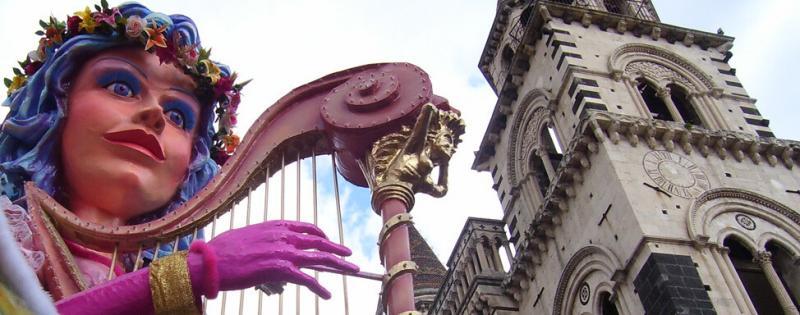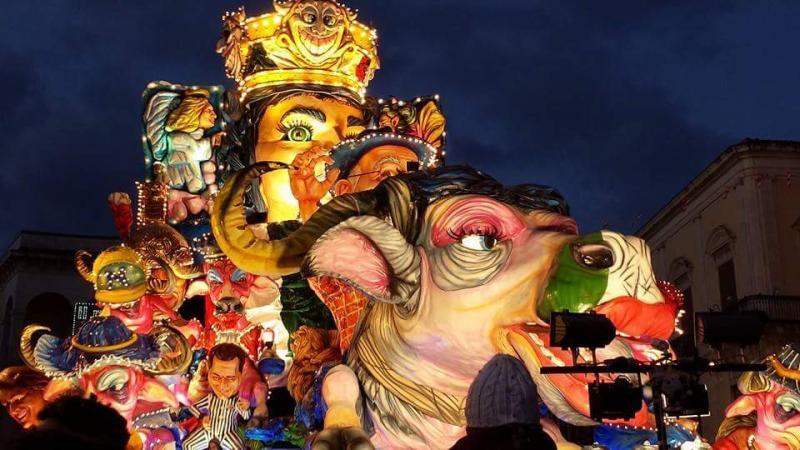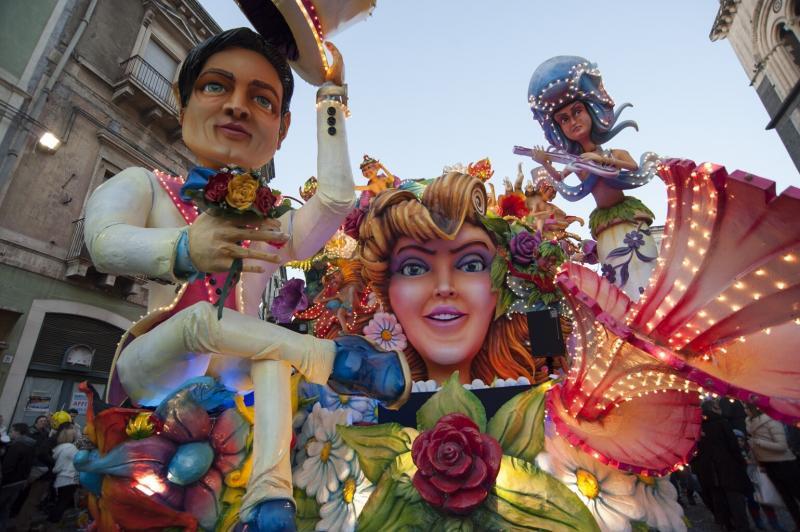Carnival of Acireale
Property included in the Register of Intangible Heritage of Sicily (REIS)
Il carnival of Acireale, defined The most beautiful Carnival in Sicily and the third in Italy, is one of the oldest on the island, and takes place every year in the city of Acireale in the province of Catania. Among its features there is the parade of allegorical and flowered floats.
I allegorical-grotesque floats in papier-mâché they are finely crafted works, which give their show through thousands of bulbs and lights, spectacular movements and constantly evolving scenographies during the performances. They are the only wagons in the world to use similar lighting systems and mechanical and hydraulic movements.
I flowered floats they have the characteristic, similar to that of various carnivals on the Côte d'Azur and Liguria, of showing subjects created entirely with (real) flowers arranged side by side. They are also equipped with mechanical movements and lights.
The Acese carnival has very ancient origins. It is thought, in fact, that the demonstration was born spontaneously among the people and therefore repeated over the years by the people, who, free from rigid constraints, could joke with a certain freedom, giving rise to saturnalia in masks where it was customary to target the powerful of the time. with satire and mockery. One of the first masks of the Acese carnival was the Abbatazzu (also called Pueta Minutizzu) who, carrying around large books, made fun of the clerical class of the time, and especially about the Abbot-Bishop of Catania, in whose diocese the town fell precisely.
The first official document that mentions the event is a payment warrant from 1594
In the XNUMXth century it was customary to make a Battaglia of oranges and lemons so much felt that on March 3, 1612 the Criminal Court was forced to ban it. At the end of the seventeenth century, the earthquake that shook eastern Sicily (Val di Noto earthquake) also decreed a period of mourning and for several years the traditional carnival was not held. But already at the beginning of the eighteenth century the event was reborn, probably also encouraged by the moment of great ferment and hopes that had been created with the post-earthquake reconstruction. Some new masks entered the scene u barons (the baron) and the very famous Manti.
The parades of allegorical floats began in 1880. Initially they were preceded by the carriages of the nobles decorated (called lecassariate o prams) and later papier-mâché floats were designed. Papier-mâché was thought of precisely because in the city there were many artisans who already used this technique for decorations.
Since 1929, the year of the establishment of the autonomous company and health resort of Acireale, the Acese Carnival has been organized as it can be admired today. From 1930 the flowered machines, or cars decorated with flowers, another peculiarity of the event that will survive to the present day, even if now set up in much larger wagons.
In some editions, floats decorated with citrus will also be created.
Over the years the figure of Tankers has pushed and increased the artistic value of the event. Among the most important tankers we remember Sebastiano Longo, Rosario Lizzio, Camillo Ardizzone, Giovanni Coco, the Parlato brothers and Luciano Scalia.
Il carnival of Acireale, defined The most beautiful Carnival in Sicily and the third in Italy, is one of the oldest on the island, and takes place every year in the city of Acireale in the province of Catania. Among its features there is the parade of allegorical and flowered floats.
I allegorical-grotesque floats in papier-mâché they are finely crafted works, which give their show through thousands of bulbs and lights, spectacular movements and constantly evolving scenographies during the performances. They are the only wagons in the world to use similar lighting systems and mechanical and hydraulic movements.
I flowered floats they have the characteristic, similar to that of various carnivals on the Côte d'Azur and Liguria, of showing subjects created entirely with (real) flowers arranged side by side. They are also equipped with mechanical movements and lights.
The Acese carnival has very ancient origins. It is thought, in fact, that the demonstration was born spontaneously among the people and therefore repeated over the years by the people, who, free from rigid constraints, could joke with a certain freedom, giving rise to saturnalia in masks where it was customary to target the powerful of the time. with satire and mockery. One of the first masks of the Acese carnival was the Abbatazzu (also called Pueta Minutizzu) who, carrying around large books, made fun of the clerical class of the time, and especially about the Abbot-Bishop of Catania, in whose diocese the town fell precisely.
The first official document that mentions the event is a payment warrant from 1594
In the XNUMXth century it was customary to make a Battaglia of oranges and lemons so much felt that on March 3, 1612 the Criminal Court was forced to ban it. At the end of the seventeenth century, the earthquake that shook eastern Sicily (Val di Noto earthquake) also decreed a period of mourning and for several years the traditional carnival was not held. But already at the beginning of the eighteenth century the event was reborn, probably also encouraged by the moment of great ferment and hopes that had been created with the post-earthquake reconstruction. Some new masks entered the scene u barons (the baron) and the very famous Manti.
The parades of allegorical floats began in 1880. Initially they were preceded by the carriages of the nobles decorated (called lecassariate o prams) and later papier-mâché floats were designed. Papier-mâché was thought of precisely because in the city there were many artisans who already used this technique for decorations.
Since 1929, the year of the establishment of the autonomous company and health resort of Acireale, the Acese Carnival has been organized as it can be admired today. From 1930 the flowered machines, or cars decorated with flowers, another peculiarity of the event that will survive to the present day, even if now set up in much larger wagons.
In some editions, floats decorated with citrus will also be created.
Over the years the figure of Tankers has pushed and increased the artistic value of the event. Among the most important tankers we remember Sebastiano Longo, Rosario Lizzio, Camillo Ardizzone, Giovanni Coco, the Parlato brothers and Luciano Scalia.
Source: Wikipedia
Visit Sicilian Intangible Cultural Heritage database to learn about other intangible assets
Visit Data Maps Heritage: Set of databases of the Sicilian Cultural Heritage to know other databases (nature, baroque, archeology, material assets and much more)
----------------
Technical sheet prepared by: Region of Sicily - Department of cultural heritage and Sicilian identity - CRicd: Regional center for inventory, cataloging and documentation and Sicilian regional film library
Intangible Heritage Register

















